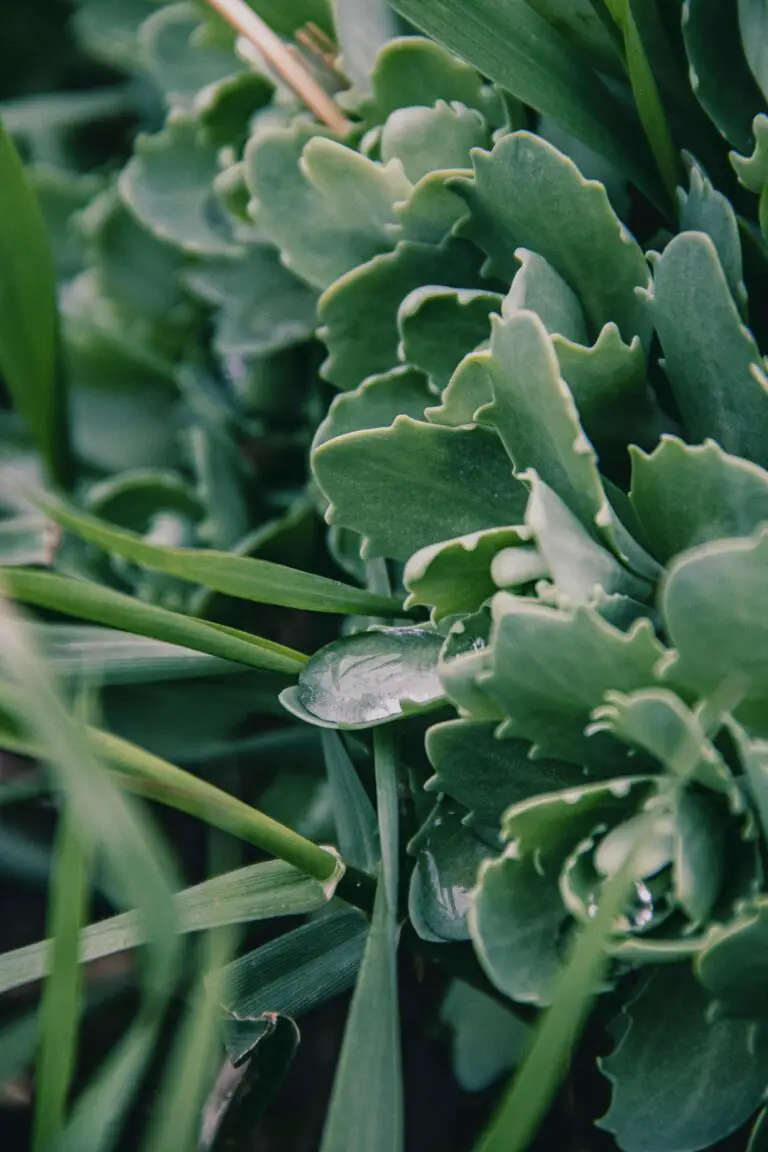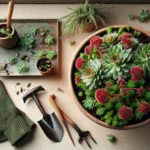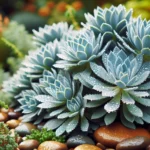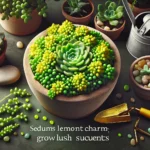Introduction to Sedum Stonecrop
Imagine a plant so resilient that it can brighten up the rugged cliffs or add a splash of color to a sleek, urban rooftop garden. Enter the marvel of the succulent world: Sedum Stonecrop. This hardy little trooper is not only a botanical wonder but also an aesthetic delight in any landscape, whether perched on high-rise green roofs or nestled in rock gardens at ground level.
Sedums, known for their distinctive fleshy leaves and captivating blooms, have a superhero-like ability to thrive in conditions that would leave other plants withering. Their secret? A mighty water-storage system within those plump leaves, allowing them to withstand drought and heat with the poise of a desert cactus. From vibrant greens to sunset reds, these plants paint a palette that would make any artist envious.
In the plant kingdom, sedums hold their heads high with effortless elegance. They’re not fussy about soil, asking for little more than a sunny spot to bask in. And when it comes to maintenance? Let’s just say they’re as low-maintenance as they come—a dream for gardeners who love a beautiful garden but don’t want to be slaves to their pruning shears.
If you’re intrigued by the numerous varieties of this succulent and how you might introduce them into your green world, why not check out our detailed guide on creating a thriving succulent garden? Prepare to delve into a realm where the sedum reigns supreme—nurturing a verdant utopia that requires minimal effort but delivers maximum impact.
Meanwhile, for a visual treat, take a peek at this engaging video that captures the essence of Stonecrop and its place in the natural tapestry:
Whether you’re a seasoned botanist or a casual nature lover, the sedum stonecrop offers a lesson in resilience and beauty that resonates deeply in today’s fast-paced, ever-changing world. So, let’s raise a trowel to these rugged beauties of the plant kingdom, shall we?
History and Origin of Sedum Stonecrop
The story of the sedum stonecrop reads like an adventure tale, with its verdant tendrils tracing a path through time and continents. Known for its rugged beauty and unwavering resilience, this succulent has etched its mark in diverse climates and landscapes, from the rocky hills of its native habitats to the bustling cities where it adorns rooftop gardens.
Countless species of sedum, each with its unique charms, have been part of human history for centuries. Gardeners and botanists alike have marveled at how these plants thrive in poor soils with little water, making them a symbol of strength and tenacity in the plant world. Writings from ancient times already celebrated their hardiness and ornamental value, showcasing a legacy that stretches as far back as the gardens of Babylon.
Originally hailing from the temperate zones and tropical mountains of regions like Asia and Europe, the sedum stonecrop has a natural knack for survival, which has enabled it to journey across oceans and establish itself in North America’s landscapes. Explore more about the world of succulents and the diverse conditions they can flourish in.
In recent times, sedum stonecrop has gained popularity for its ecological benefits, particularly in the construction of green roofs. Their ability to insulate buildings and reduce urban heat islands is just another chapter in their storied existence—and it’s one we’re actively writing today.

Whether in a quaint cottage garden or a sprawling green roof, sedum stonecrop continues to make history with its simple elegance and unparalleled adaptability. It stands as a testament to the incredible journey of plants and the harmonious intersection of the wild and the cultivated in our shared environment.
Diversity within the Stonecrop Family
When you think of sedum stonecrop, you might envision a single variety of this hardy succulent. But hold onto your garden hats, because the stonecrop family is a treasure trove of diversity! Each species sparkles with its own personality, making them a gem for both gardens and green roofs alike.
Take the radiant Sedum spectabile for example; it’s like the sun decided to plant kisses on the earth, blessing us with clusters of star-shaped pink blossoms. Hardy and drought-tolerant, this variety mingles beautifully in a perennial border, creating a buzz with friendly pollinators. Then, there’s the dainty Sedum acre, a low-growing trooper that forms a lush carpet of greenery, sprinkling yellow flowers like confetti across your garden floor.
But don’t just take my word for it. Did you know there are over 400 distinctive types of sedum? These range all the way from tight ground covers to tall, stately stalks that stretch to the sky. And while these plants revel in their differences, they all share one common trait: resilience.

On your next stroll through a garden or a visit to our site, explore our deep dive into the wonderful world of succulents for a thorough exploration of stonecrop varieties and their cousins. While you’re there, immerse yourself in the stories of each sedum—like the bold Sedum reflexum, sporting its spiky blue-green foliage, or the autumnal Sedum telephium, which offers a seasonal show of deep purple leaves.
Stonecrop’s adaptability to a wide range of conditions, from baking rooftops to shaded rockeries, is nothing short of amazing. They truly are nature’s reminder that in diversity, there’s beauty and strength—an inspiring message that resonates beyond the garden’s edge.
Why Gardeners Love Sedum Stonecrop
Ask any green thumb why they’re smitten with sedum stonecrop, and you’ll hear a symphony of praises. This plucky succulent comes with a toolkit built for survival, making it a top pick for gardens and green roofs alike. Let’s warm up to sedum by diving into the attributes that give it rockstar status among plants!
It’s a bit like Mother Nature designed sedum with the forgetful gardener in mind. Drought? Bring it on! Sedum thrives in conditions that would make other plants wilt shamefully. Why’s this, you ask? Their juicy leaves store water like a camel’s hump, letting them coast through dry spells without breaking a sweat (or is it a dew?).
Now, let’s paint a picture: Imagine a sun-soaked rooftop buzzing with life, a tapestry of sedums painting it green, pink, and red. They require little soil, scoff at pests, and ask for nearly no maintenance. Green roofs are popping up in cities where space is tight, and sedums are like the avant-garde architects of these elevated gardens. Peak resilience? Check. Stunning looks? Double-check!
Sedums set the stage for perennial beauty, offering a spectacle from spring to frost. In a suburban landscape, envision a xeriscaped garden where sedums stand undeterred by the summer heat, their roots gripping the earth like anchors. Neighbors peek over the fence, whispering, “How do they do it?” They’re not just surviving; they’re hosting a photosynthetic fiesta.
Let’s not forget the aesthetic allure sedums bring to the table. Whether cascading over a stone wall or nestled within a cottage garden, they add layers of texture and color. And when the fall chill sets in? Sedum stonecrop’s foliage shifts like an artist’s palette, showcasing deep rusts and vibrant golds—nature’s own fireworks display, signaling a finale to the growing season.
With a resilience that whispers tales of survival across seasons and a beauty that speaks poetry to the eyes, sedum stonecrop continues to capture the hearts of gardeners. It’s not just a plant; it’s a testament to nature’s ingenuity and the joy that gardening brings.
Ideal Conditions for Growing Sedum
Let’s get down to the nitty-gritty of growing the ever-resilient sedum stonecrop. Whether you’re a green-thumbed guru or a budding gardener, understanding the sweet spot for sedum cultivation is key to thriving plants. Picture yourself surrounded by lush, low-maintenance sedum—a dream for those seeking a gorgeous garden with minimal fuss.
Sunlight: The Solar Embrace
First things first, sedum is a sun-worshipper. Its ideal day is spent basking in full sunlight, soaking up those golden rays. But don’t worry, it’s not a diva. Sedum can handle a bit of shade, yet for those eye-catching blooms and tight, compact growth, a spot under the sun is prime real estate. Think about placing them in those sunny patches where other plants might throw in the towel.
Soil Savvy
When it comes to soil, sedum isn’t picky, but it has a clear preference for well-draining terrain. Imagine sandy or gravelly soils, and you’re on the right track. Heavy, wet clay? Not so much. Sedum’s roots like to drink but despise soggy shoes. A tip for those dealing with less-than-ideal soil: raise your planting bed to improve drainage.
Watering Wisdom
Overwatering is the nemesis of many succulents, sedum included. These plants have the hydration game figured out, storing water in their plump leaves for a non-rainy day. So, go easy on the H2O. Water your sedum thoroughly, then allow the soil to dry out completely between drinks. It’s like giving them a refreshing gulp, not submerging them in a bath!
By honoring these simple but essential criteria, your sedum stonecrop won’t just grow; it’ll soar with vitality. From green roofs that outsmart the urban heat island effect to garden beds that shimmer with their star-shaped blooms, sedum proves time and again why it’s a favorite among plants that pack a hardy punch.
Still thirsty for more sedum success stories? Take a peek at this video showcasing why sedum stonecrop is an unparalleled champion in the plant world:
Sedum Stonecrop as a Ground Cover
Gardeners and landscapers are constantly on the hunt for low-maintenance, resilient plants that not only look great but also help in creating a more sustainable environment. Enter Sedum stonecrop, a hardy succulent that’s a top-notch candidate for ground cover. Whether you’re looking to jazz up a patch of earth or intent on greening a vast rooftop, these unassuming plants pack a punch when it comes to coverage and soil health.
Sedum stonecrop possesses remarkable qualities that enable it to carpet an area with a lush, leafy layer. Its dense growth habit suppresses weeds, reducing the need for chemical herbicides. Plus, the foliage of sedum stonecrop retains moisture, contributing to a micro-ecosystem that’s both moisture-efficient and supportive to adjacent plant life.
Real-life examples of sedum stonecrop’s success are evident in eco-friendly rooftop gardens in urban sprawls. These green roofs have become sanctuaries within concrete jungles, attracting pollinators and providing a haven for a myriad of creatures and critters. Down at ground level, sedum varieties intermingle with the likes of perennials and spring bulbs, showcasing their versatility and their ability to coexist in diverse planting schemes.
The impact on soil health cannot be understated. Sedum helps combat erosion with its interlocking root system, creating a firm, living mat that anchors the soil beneath. Its presence encourages soil aeration and fertility, promoting a healthier garden bed not just on the surface, but down deep where the roots dwell.
Implementing sedum stonecrop as ground cover isn’t a Herculean task. It’s as simple as selecting an apt variety for your climate, prepping the soil, and laying out the sedum plants. These succulents are like miniature eco-warriors, spreading willingly over time to provide a gorgeous, green tapestry that’s both visually appealing and environmentally advantageous.
Green Roofing with Sedum
The burgeoning trend of green roofing has found a resilient and vibrant ally in sedum stonecrop. Revered for its hardy nature and minimal maintenance requirements, sedum is transforming urban landscapes into eco-friendly havens. Imagine a bustling cityscape, now interlaced with verdant roofs, each a miniature oasis thriving above the concrete.
Sedum stonecrop, a standout succulent in the world of green roofing, is an environmental powerhouse. Its dense foliage not only offers a lush carpet of varying hues but also serves a crucial role in biodiversity preservation. Picture a rooftop in spring – it’s a pollinators’ paradise, teeming with bees and butterflies that are essential for urban ecosystems.

Moreover, sedum-roofed buildings are models of efficiency. They exemplify nature’s ingenuity in cooling and insulation. During sweltering summer days, these living roofs reduce the need for air conditioning, while in winter, they act as insulating blankets, conserving heat. The result? A significant cutback in energy consumption and a tangible reduction in urban heat islands.
In cities such as Toronto and Portland, where green roofs are encouraged, sedum is a frequent sight. These municipalities have recognized the immense benefits that such vegetation brings to the urban fabric. Through the seasons, sedum proves its mettle by standing up to harsh weather, demanding little in return, and providing an evergreen aesthetic that softens the city’s edges.
By adopting sedum stonecrop, modern architecture has the chance to forge a sustainability statement that is not only visually appealing but teeming with life. It’s a living, breathing installation that underscores our commitment to a greener future, one rooftop at a time.
Propagating Your Sedum Plants
Dreaming of a sea of sedum but not keen on splashing the cash? Let’s turn your dreams into reality with a snip here, a plant there, and voilà—your garden oasis awaits, overflowing with sedum stonecrop without breaking the bank! Remember, nature’s generosity is boundless, and sedum, with its robust charm, is no exception. It’s like having a plant fountain of youth at your fingertips—endless growth from just a few pieces.
The Magic Begins with a Cutting
It’s as simple as taking a casual stroll through your garden scissors in hand. Spy a succulent sedum? Excellent! Snip off a healthy stem, about two-to-six inches long, ideally from a non-flowering part to ensure maximum energy for root growth. The cut should be clean—imagine you’re a skilled surgeon in the operating room of your backyard.
Why non-flowering? Think of it as focusing the plant’s strength not on a sprint (flowering) but on a marathon (root development). It’s all about priorities, and we’re in it for the long haul.
Preparing the Stage for Success
Next up, we let our cuttings dress for the part, strip them of any lower leaves, and lay them out like sunbathers—let them rest and callous over for a few days. Air curing is the name of the game here, a key step to prevent any unwelcome fungal gatecrashers at our propagation party.
Once ready, the planting stage is pretty laid-back: a light, free-draining soil mix or even pure perlite will do. Poke them in, settle them down, and give them a gentle sip of water—think of it as a welcoming toast to their new home.
Patience, the Gardener’s Virtue
Our sedum sojourners don’t demand much—just some polite watering when the soil seems parched. They emulate the admirable patience of a zen master, awaiting the perfect moment to flaunt their root growth. As days turn to a week or two, under the soil’s cover, a mini-miracle occurs: new, tiny roots emerge, eager to anchor themselves to their new world.
Here’s where you play the proud parent, watching as your once humble cuttings transform, putting down roots and sprouting new leaves. With each passing day, they become more self-sufficient, ready to face the elements and bask in the admiration of bees and butterflies.
Watch and Learn from the Propagation Pros
For those of us who are visual learners, never fear—here’s a video walk-through to show you exactly how it’s done. Watch how these sedum cuttings go from being mere stick figures to full-fledged, green-leaved beauties.
Armed with a little know-how and a dash of patience, you’ll find propagating sedum stonecrop is a breeze. It’s a sustainable, cost-effective way to fill your garden or green roof with these drought-tolerant succulents. So, what are you waiting for? Get snipping, and let the lush, leafy takeover begin!
Common Pests and Problems
So, you’ve chosen the resilient sedum stonecrop for your garden or green roof—a stellar choice! But let’s talk brass tacks: even this hardy succulent can play host to unwelcome guests and troubles. We’re going to walk you through some common foes of this plucky plant and give you the lowdown on how to send them packing.
Pesky Pests That Pester Sedum Stonecrop
First up, aphids. Imagine you’re sipping your morning coffee and you spot some sticky, honeydew secretions on your stonecrop. Chances are, you’ve got aphids. These little sap-suckers love to throw a garden party on your plant’s expense. They’re like those guests who eat all your snacks and leave a mess—but worry not! A blast of water or insecticidal soap usually shows them the door.
Another critter that might crash the sedum soiree are mealybugs. Picture this: fluffy white patches that look like tiny cotton plantations on the stems and undersides of leaves. If you see these, it’s time for action. Dabbing them with alcohol on a q-tip or using neem oil can act like a bouncer, keeping these pests from overstaying their welcome.
Dreadful Diseases Decimating Sedum
Next, let’s talk diseases. Powdery mildew is one such villain, showing up as a white powdery layer—like your sedum stonecrop just dusted itself with flour before baking. It’s not prepping for a bake-off; it’s a fungal issue that likes to lurk around when the air is damp. Keep your plants dry and spaced out, and apply fungicides if it gets too cheeky.
Overly wet conditions can also lead to root rot. You’d think a succulent would appreciate all the hydration, but too much of a good thing is real. When the roots are drowning, they might as well wave a little white flag. Prevent this soggy situation with well-draining soil and watch your watering habits—more of a sprinkle than a splash.
Now, let’s see this in action. Check out this video for some sage advice on keeping your sedum in tip-top condition:
Frequently Asked Questions About Sedum Stonecrop
Step into the world of sedum stonecrop, the resilient little succulent that’s making a big splash in gardens and on green roofs worldwide. We’re digging into the gritty details with some real-life examples, and you’re invited to get your hands dirty with us. So, let’s jump right into the dirt—figuratively speaking—and get those pressing questions answered.
Caring for Sedum Stonecrop: How Hard Can it Be?
Imagine this: You’ve just picked up your first batch of sedum stonecrop from the local nursery. You’re brimming with excitement and can’t wait to see those succulent leaves thrive under your care. But how do you ensure your stonecrop doesn’t turn into… well, a stone flop? It’s easier than you think! Sedum is drought-tolerant and doesn’t need much babysitting. Make sure you place it in well-draining soil, give it plenty of sunlight, and water it sparingly. Remember, this is a succulent that’s used to tough love!
Troubleshooting Tips: When Your Sedum Stonecrop Hits a Bump
Let’s set the scene: You’ve noticed your sedum’s leaves are drooping, or perhaps they’re not as vibrant as they were when you planted them. Don’t panic! Often, it’s a sign of overwatering. Sedum stonecrop prefers to be on the dry side, so ease up on the H2O. And if your little green buddy is stretching out and looking a bit leggy, it’s craving more sunlight. Move it to a sunnier spot and watch it perk up. It’s all about tuning in to your plant’s performance and adjusting your care strategy accordingly.
Need a visual aid? Here’s a hands-on video tutorial that will show you how to keep your sedum stonecrop in tip-top shape.
Optimal Plant Health: The Sedum Stonecrop Secret
You know that neighbor with the envy-inducing garden, always lush and lively? Here’s their secret: They might be using sedum stonecrop as a robust, yet charming ground cover or a rooftop garden gem. This plant isn’t just about good looks; it’s a mini ecosystem warrior, too. Sedum attracts pollinators like bees and butterflies, making your garden a buzzing haven. The trick for optimal health is not to overcrowd them—give them space to breathe and flourish. And don’t forget, a little fertilizer in the growing season won’t hurt either.
There you have it, friends! Simple steps for anyone to follow, whether you’re a green thumb guru or a budding garden enthusiast. Now, go forth and let your sedum stonecrop shine!



